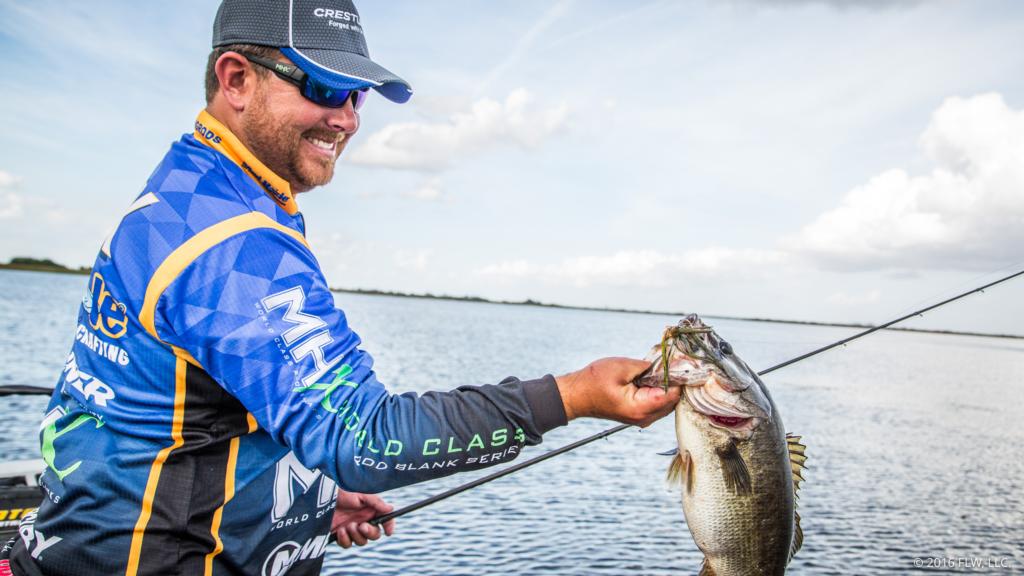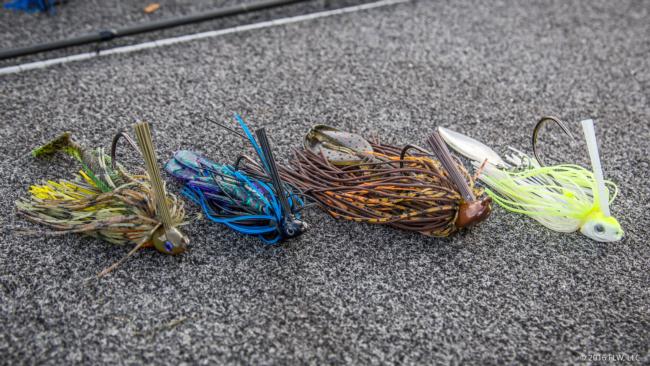John Cox’s Top 4 Swim Jigs
What the Forrest Wood Cup champ throws when the bass want a swim jig

Swim jigs are some of the most effective and versatile lures around, and that isn’t lost on John Cox. Swimming a jig fits the Forrest Wood Cup champ’s shallow style perfectly, and he seems to always weigh in bass caught with the technique. To get the most out of swimming a jig, Cox has done a lot of experimenting and says he’s settled on not one, but four different swim jigs.
Covering the bases
Cox relies so heavily on swim jigs that he has options to cover all his bases.
“I have one for pretty much everything because you can throw the swim jig in anything and everything,” he says. “It’s like a Speed Worm: You can work it real high in the water column, you can work it in between and you can work it on the bottom.
“I’m looking for ‘The Jig’ – one jig that can do it all – and I haven’t found it yet,” Cox says. “Maybe one of these days someone will figure it out, but right now you have to have a variety of them.”
The swim jigs listed here align with the photo above, going from left to right.
1. Dirty Jigs No-Jack Swim Jig
For grass, Cox says he uses two different jigs. The first is the Dirty Jigs No-Jack Swim Jig. He prefers the 1/2-ounce model and likes to fish it around grass that is thin enough to crank through it or deep enough to reel over the top of it. Because it’s a pretty big, heavy jig, Cox says it’s best when the bass are really feeding. For his rod, Cox likes a 7-foot, 6-inch, medium-heavy MHX MB903 with 50-pound-test braid.
2. Eco Pro Tungsten Sick Boy Swim Jig
Cox’s second grass jig is the small Eco Pro Tungsten Sick Boy Swim Jig.
“When it’s tougher or the bite’s just not there, I throw the smaller Eco Pro,” says Cox. “It’s a 1/4-ounce jig, and it has a tungsten head and a really small profile. I put a Zoom Speed Craw on the back of it. That’s good for a little bit thicker grass, where it’s hard to throw a heavier jig through it.”
For that jig, Cox likes either a spinning rod with 30-pound-test braid or 15-pound-test fluorocarbon with a 7-foot, medium-heavy MB843 baitcasting rod.
3. Buckeye Lures Mop Jig
The third jig in the Florida pro’s arsenal is the Buckeye Lures Mop Jig.
“It’s the one I throw more around wood and trees and docks, more hard cover or open water, places where there’s not any grass,” Cox says. “It’s got a flat head on the front of it, and it seems to bounce off all the hard objects really well. It has a round rubber skirt too, and I like that because it gives it a little more profile around open-water stuff.”
He uses the same rod as in No. 1 – an MB903.
4. Pepper Custom Baits Boom Boom Plus Jig
Finally, Cox likes to employ the Pepper Custom Baits Boom Boom Plus Jig, which has a trailing willow-leaf blade, under conditions that would normally favor a spinnerbait.
“I like it a lot when it’s cloudy, or if it’s raining,” says Cox. “Sometimes I’ll take a Reaction Innovations Skinny Dipper and slide it up and cut the tail off just so there’s just some plastic there. You have to clip the tail though because the tail gets in the way of the blade if you don’t. I’ll crank it like you would a spinnerbait, just changing it up to see what they want.”
For that, he uses the same setup he would for a spinnerbait, a 7-foot, 3-inch, medium-heavy MB873 with 20-pound-test fluorocarbon.
The finer points
For trailers, Cox usually uses a Skinny Dipper, and likes to match the color to the jig as closely as he can. Occasionally, he’ll use a trail that is close in color but doesn’t match the jig, though he says he rarely throws contrasting colors.
“I notice that the smallest difference in some of these swim jigs makes a huge difference,” says Cox. “From what they’re coming through to how the head pushes water around them to how the trailer will act depending on the head shape, it’s really endless. I’ve seen how just a little change on the line tie can make it come through grass better.”
Cox is a master at getting the most out of limited fish by constantly making small adjustments to his presentation. Swim jigs are especially great for that, not only because of the many fine tweaks you can make with different jigs and trailers, but also because they support a myriad of retrieves. Swim jigs have long been a weapon in bass fishing, and Cox goes out of his way to fish them in off-the-wall situations. You should too.
